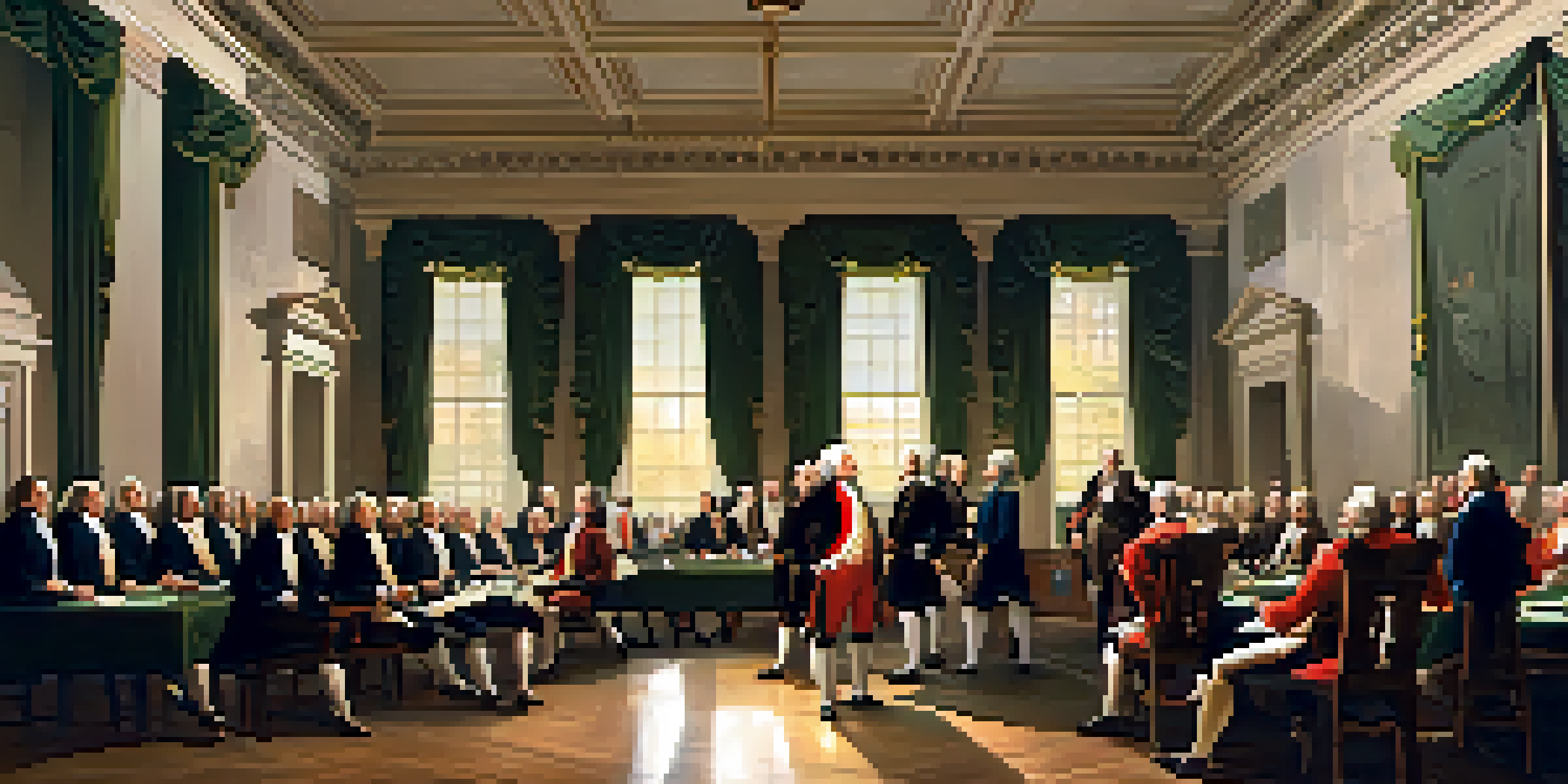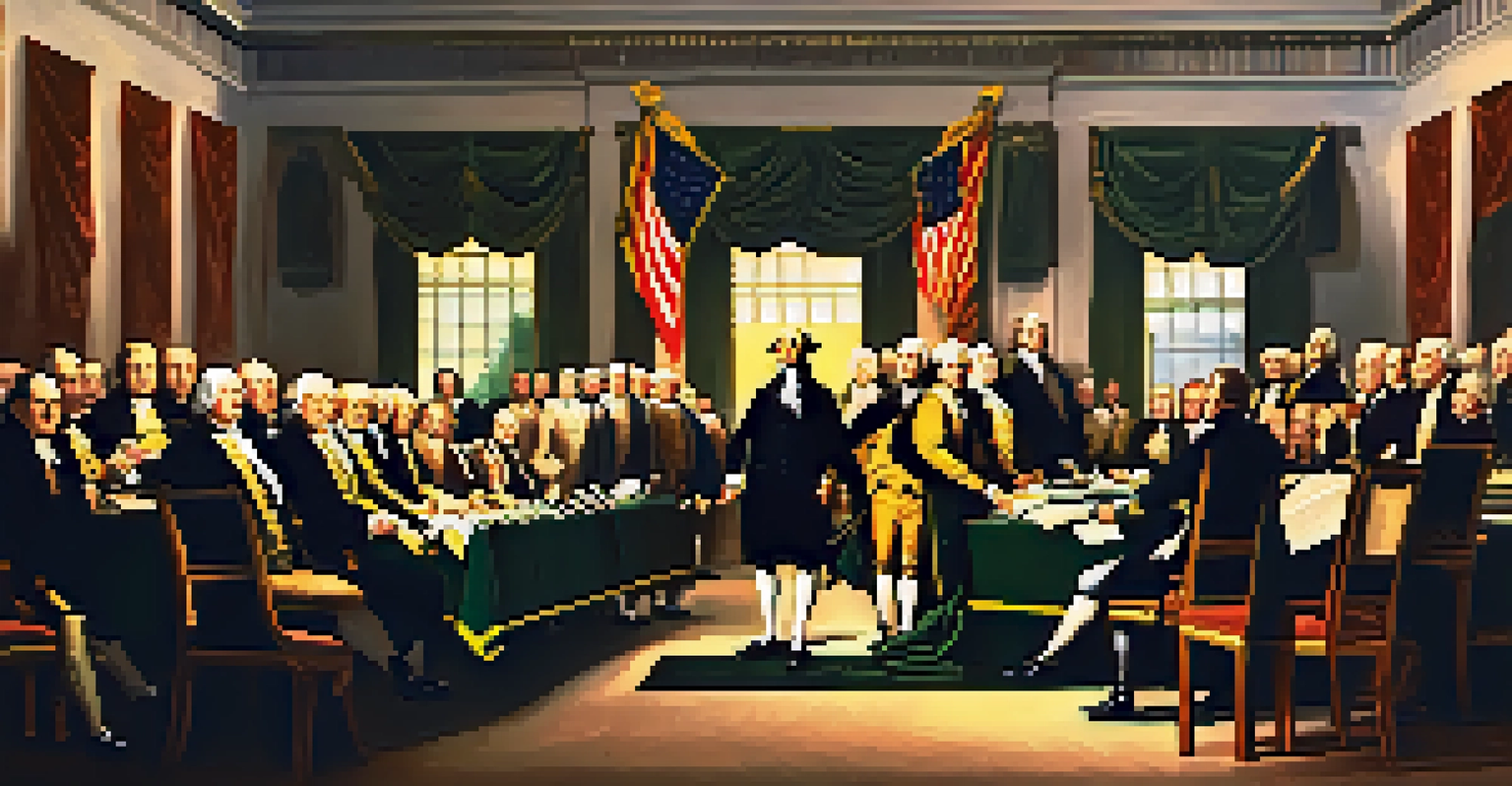The Constitutional Convention: Philadelphia's Political Legacy

Understanding the Context of the Convention
The Constitutional Convention took place in Philadelphia in 1787, a time when the young United States was struggling with its identity. The Articles of Confederation had proven inadequate, leading to economic instability and political chaos. This backdrop set the stage for delegates to gather and deliberate on a new framework for governance, aiming to create a stronger federal system.
Compromise is the oil that makes government go.
Delegates from twelve of the thirteen states (Rhode Island opted out) came together, bringing diverse perspectives and interests. They were motivated by the desire to improve their fledgling government while also ensuring that individual liberties were protected. The stakes were high, and the discussions would ultimately shape the future of the nation.
In many ways, the convention was a microcosm of the larger American society, with debates reflecting regional differences and ideological divides. This tension fueled the discussions, leading to compromises that would be essential in crafting the Constitution.
Key Figures at the Convention
The convention was marked by the leadership of several key figures, whose influence would prove crucial in shaping the Constitution. George Washington, elected as president of the convention, brought a sense of authority and respect that helped maintain order during heated debates. His leadership style encouraged collaboration and compromise among the delegates.

Other notable figures included James Madison, often referred to as the 'Father of the Constitution,' who played a significant role in drafting the document. Madison's extensive notes during the convention provide us with valuable insights into the discussions and thought processes of the time. His commitment to balancing power among the branches of government was instrumental in the final outcome.
Compromise Shaped the Constitution
The delegates at the Constitutional Convention recognized the necessity of compromise to address differing state interests and craft a unifying document.
Additionally, Benjamin Franklin’s wisdom and diplomacy helped ease tensions among delegates, fostering a spirit of cooperation. His ability to bridge gaps between differing factions was vital in ensuring that the convention did not dissolve into chaos.
Major Debates and Compromises
The debates at the convention were intense, with critical issues such as representation, federalism, and slavery at the forefront. One major point of contention was how states would be represented in the new government. The Virginia Plan proposed representation based on population, while the New Jersey Plan advocated for equal representation for all states.
The Constitution is not an instrument for the government to restrain the people, it is an instrument for the people to restrain the government.
The Great Compromise emerged from these discussions, establishing a bicameral legislature with both proportional and equal representation. This compromise was vital in ensuring that both large and small states felt heard and represented, laying the groundwork for the legislative process in the United States.
Another contentious issue was slavery, which prompted heated debates that revealed deep regional divides. Ultimately, compromises such as the Three-Fifths Compromise were reached, allowing states to count three-fifths of their enslaved population for representation purposes. While these compromises were necessary for unity, they also left unresolved tensions that would resurface in American history.
The Role of Federalism
Federalism, the division of power between the national and state governments, was a central theme at the convention. The framers aimed to strike a balance that would prevent any single entity from becoming too powerful. This system was a response to the perceived weaknesses of the Articles of Confederation, where states wielded significant authority.
The Constitution delineates specific powers for the federal government while reserving others for the states. This dual system was revolutionary at the time and has since become a defining feature of American governance. It allows for local autonomy while maintaining a cohesive national policy.
Federalism Balances Power
The framers established federalism to divide power between national and state governments, preventing any single entity from becoming too powerful.
However, the debates surrounding federalism also highlighted concerns about overreach and the potential for tyranny. The Bill of Rights, added shortly after the Constitution’s ratification, was a crucial response to these fears, ensuring that individual liberties were protected from governmental infringement.
The Ratification Process
Once the Constitution was drafted, the next challenge was ratification. The document required approval from nine of the thirteen states to take effect, leading to vigorous public debates. Supporters, known as Federalists, argued for the Constitution's ratification, emphasizing the need for a strong central government to maintain order and promote economic stability.
Opponents, known as Anti-Federalists, voiced concerns about the potential for government overreach and the lack of explicit protections for individual rights. This opposition sparked intense discussions, with pamphlets and public forums becoming common venues for debate. The discourse highlighted the importance of civic engagement in shaping the nation’s future.
Ultimately, the promise of a Bill of Rights helped to secure the necessary support for ratification. This compromise not only addressed the concerns of Anti-Federalists but also showcased the convention's legacy of negotiation and adaptability. The Constitution was ratified in 1788, paving the way for the establishment of the United States government.
Impact on American Political Culture
The Constitutional Convention laid the groundwork for American political culture, establishing principles that continue to resonate today. Concepts like checks and balances, separation of powers, and the rule of law became foundational to the United States' democratic framework. These principles ensure that no single branch of government can wield unchecked power.
Moreover, the Constitution fosters a culture of debate and compromise, encouraging citizens to engage in discussions about governance and policy. This legacy is evident in contemporary political discourse, where differing viewpoints are often debated in the public sphere. The convention's spirit of collaboration serves as a reminder of the importance of dialogue in a functioning democracy.
Civic Engagement Drives Democracy
The debates surrounding the Constitution highlighted the importance of civic engagement and public discourse in shaping effective governance.
As the nation has evolved, the Constitution has also demonstrated its capacity for adaptation, with amendments reflecting changing societal values. This ability to amend the foundational document highlights the dynamic nature of American democracy, allowing it to remain relevant in an ever-changing world.
Lessons from the Constitutional Convention
The Constitutional Convention offers valuable lessons that extend beyond its historical context. One key takeaway is the importance of compromise in governance. The delegates recognized that differing perspectives were necessary for a functioning democracy, and their ability to negotiate and find common ground was crucial in forging the Constitution.
Additionally, the convention underscores the significance of civic engagement and participation in shaping policy. The debates and discussions at the convention were fueled by the involvement of informed citizens, reminding us that active participation is essential for a healthy democracy. The legacy of the convention encourages us to remain engaged in political processes today.

Lastly, the challenges faced during the convention illustrate the complexity of creating a government that serves diverse interests. The ongoing evolution of the Constitution reflects the need for flexibility and responsiveness in governance, teaching us that change is not only possible but necessary for progress.